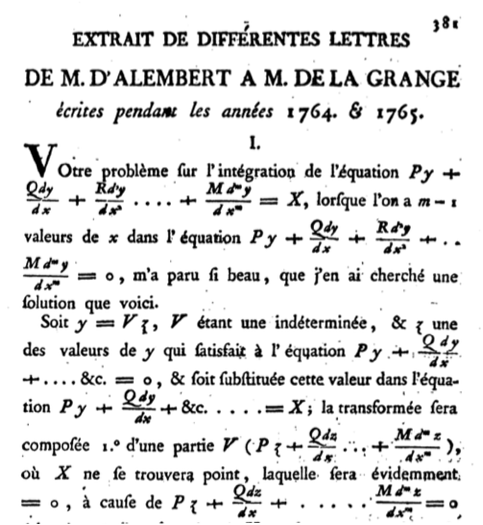- About MAA
- Membership
- MAA Publications
- Periodicals
- Blogs
- MAA Book Series
- MAA Press (an imprint of the AMS)
- MAA Notes
- MAA Reviews
- Mathematical Communication
- Information for Libraries
- Author Resources
- Advertise with MAA
- Meetings
- Competitions
- Programs
- Communities
- MAA Sections
- SIGMAA
- MAA Connect
- Students
- MAA Awards
- Awards Booklets
- Writing Awards
- Teaching Awards
- Service Awards
- Research Awards
- Lecture Awards
- Putnam Competition Individual and Team Winners
- D. E. Shaw Group AMC 8 Awards & Certificates
- Maryam Mirzakhani AMC 10 A Awards & Certificates
- Two Sigma AMC 10 B Awards & Certificates
- Jane Street AMC 12 A Awards & Certificates
- Akamai AMC 12 B Awards & Certificates
- High School Teachers
- News
You are here
D'Alembert, Lagrange, and Reduction of Order - The History
Our modern method for reduction of order is due to the French mathematician and physicist Jean le Rond d'Alembert (1717-1783) in 1766 [3, p. 381]. Figure 1 shows d'Alembert published exactly our method.
 |
|
Your problem on integrating the equation \(Py+\frac{Q dy}{dx}+\frac{Rd^2y}{dx^2} \dots + \frac{M d^my}{dx^m}=X\) when one has \(m-1\) values of \(x\) [sic] in the equation \(Py+\frac{Q dy}{dx}+\frac{Rd^2y}{dx^2} \dots + \frac{M d^my}{dx^m}=0\) seems so beautiful to me that I've looked for a solution myself, which follows. Let \(y=V\xi\), \(V\) being undetermined, and \(\xi\) one of the values of \(y\) that satisfies the equation \(Py+\frac{Q dy}{dx}+ \dots \& c.=0\) and so this value be substituted in the equation \(Py+\frac{Q dy}{dx}+ \& c. \dots=X\). The transformed will be composed of, 1) one part \(V(P\xi+\frac{Q d\xi}{dx}\dots + \frac{M d^m\xi}{dx^m})\)… where \(X\) does not exist, so it will evidently \(=0\), because \(P\xi +\frac{Q d\xi}{dx}\dots + \frac{M d^m\xi}{dx^m}=0\)... |
Figure 1. D'Alembert explained what remains the modern method for reducing the order of a linear differential equation in 1766 [3, p. 381]. D'Alembert's French is followed by the authors' translation into English.
What is interesting, and what provides motivation for the rest of this paper is the title of his article: “Extrait de différentes lettres de M. d'Alembert à M. de la Grange écrites pendant les années 1764 & 1765" (“Excerpt from different letters between Mr. d'Alembert and Mr. de LaGrange written during the years 1764 & 1765”). It appears that this technique comes from a conversation with Joseph-Louis Lagrange (1736-1813). To learn more, we examine the letters shared between these mathematicians.
Sarah Cummings (Wittenberg University) and Adam E. Parker (Wittenberg University), "D'Alembert, Lagrange, and Reduction of Order - The History," Convergence (September 2015)




